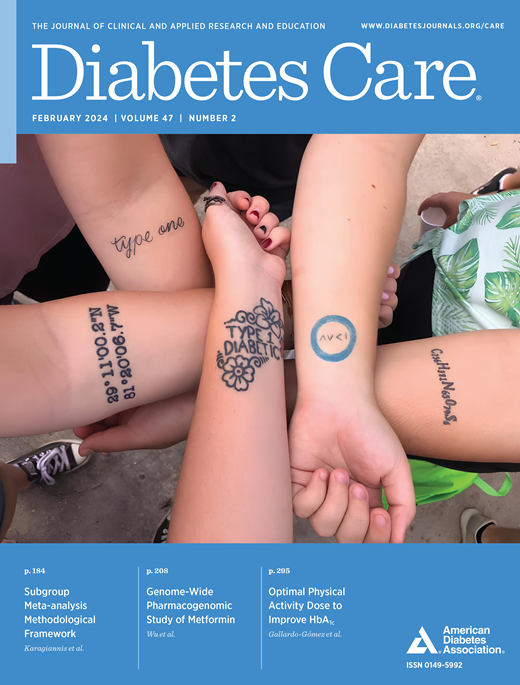Osteoprotegerin, Osteopontin, and Osteocalcin Are Associated With Cardiovascular Events in Type 2 Diabetes: Insights From EXSCEL
IF 14.8
1区 医学
Q1 ENDOCRINOLOGY & METABOLISM
引用次数: 0
Abstract
OBJECTIVE To evaluate the association of four bone metabolism biomarkers (osteoprotegerin, osteopontin, sclerostin, and osteocalcin) with cardiovascular events in people with type 2 diabetes (T2D). RESEARCH DESIGN AND METHODS The Exenatide Study of Cardiovascular Event Lowering (EXSCEL) was a randomized clinical trial evaluating the cardiovascular (CV) safety and efficacy of once-weekly exenatide for patients with T2D. Candidate biomarker data were selected from proteomic profiling performed at baseline and 12 months after randomization samples by SomaScan assay in 5,473 trial participants. The primary composite outcome was the first occurrence of CV death, nonfatal myocardial infarction, or nonfatal stroke (major cardiovascular events [MACE]). Cox proportional hazards models controlling for confounders were used for time-to-event analyses to calculate hazard ratios (HRs) with 95% CI for a 1 SD increase in the biomarker concentrations. RESULTS The primary outcome occurred in 813 participants (14.9%). Higher levels of osteoprotegerin (HR 1.11; 95% CI 1.03–1.20; P = 0.0047) and osteopontin (HR 1.10; 95% CI 1.02–1.18; P = 0.0095) were associated with an increased risk of MACE. The addition of osteoprotegerin and osteopontin to a clinical predictive model containing traditional CV risk factors provided minimal incremental value for MACE prediction (C-index 0.629 vs. 0.638; likelihood ratio test P < 0.001). Osteocalcin and sclerostin were not associated with MACE. Osteocalcin had a nonlinear association with all-cause death and with CV death. CONCLUSIONS Higher levels of osteoprotegerin and osteopontin are associated with an increased risk of CV events in people with T2D, supporting the hypothesis that pathways involved in bone metabolism play a role in CV disease.骨保护蛋白、骨生成素和骨钙素与 2 型糖尿病患者的心血管事件有关:来自 EXSCEL 的启示
目的 评估四种骨代谢生物标志物(骨蛋白激酶、骨结合蛋白、硬骨蛋白和骨钙素)与 2 型糖尿病 (T2D) 患者心血管事件的关系。研究设计与方法 艾塞那肽降低心血管事件研究(EXSCEL)是一项随机临床试验,旨在评估2型糖尿病患者每周服用一次艾塞那肽的心血管(CV)安全性和有效性。候选生物标志物数据选自5473名试验参与者在基线和随机化样本12个月后通过SomaScan检测进行的蛋白质组分析。主要的综合结果是首次发生心血管死亡、非致命性心肌梗死或非致命性中风(主要心血管事件 [MACE])。时间到事件分析采用了控制混杂因素的 Cox 比例危险模型,以计算生物标记物浓度每增加 1 SD 的危险比 (HRs) 和 95% CI。结果 813 名参与者(14.9%)出现了主要结果。较高水平的骨蛋白激酶(HR 1.11;95% CI 1.03-1.20;P = 0.0047)和骨蛋白酶(HR 1.10;95% CI 1.02-1.18;P = 0.0095)与 MACE 风险增加相关。在包含传统 CV 风险因素的临床预测模型中加入骨保护蛋白和骨素,对 MACE 预测的增量价值微乎其微(C 指数 0.629 vs. 0.638;似然比检验 P < 0.001)。骨钙素和硬骨素与 MACE 无关。骨钙素与全因死亡和冠心病死亡呈非线性关系。结论 较高水平的骨保护素和骨素与 T2D 患者发生心血管事件的风险增加有关,这支持了骨代谢途径在心血管疾病中发挥作用的假设。
本文章由计算机程序翻译,如有差异,请以英文原文为准。
求助全文
约1分钟内获得全文
求助全文
来源期刊

Diabetes Care
医学-内分泌学与代谢
CiteScore
27.80
自引率
4.90%
发文量
449
审稿时长
1 months
期刊介绍:
The journal's overarching mission can be captured by the simple word "Care," reflecting its commitment to enhancing patient well-being. Diabetes Care aims to support better patient care by addressing the comprehensive needs of healthcare professionals dedicated to managing diabetes.
Diabetes Care serves as a valuable resource for healthcare practitioners, aiming to advance knowledge, foster research, and improve diabetes management. The journal publishes original research across various categories, including Clinical Care, Education, Nutrition, Psychosocial Research, Epidemiology, Health Services Research, Emerging Treatments and Technologies, Pathophysiology, Complications, and Cardiovascular and Metabolic Risk. Additionally, Diabetes Care features ADA statements, consensus reports, review articles, letters to the editor, and health/medical news, appealing to a diverse audience of physicians, researchers, psychologists, educators, and other healthcare professionals.
 求助内容:
求助内容: 应助结果提醒方式:
应助结果提醒方式:


